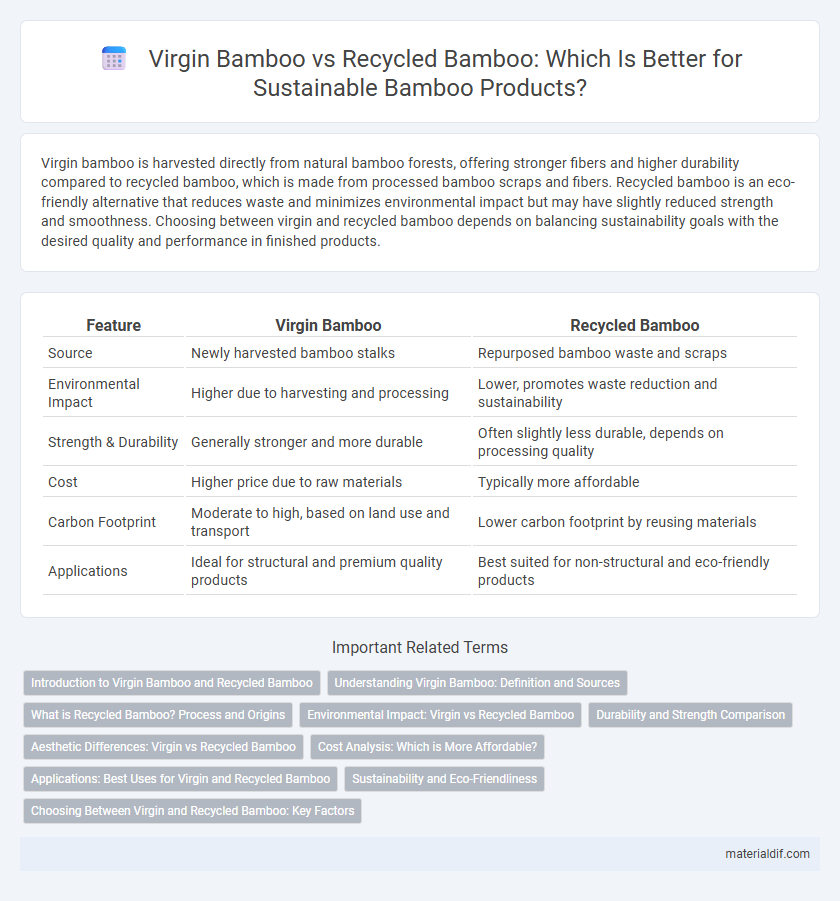Virgin bamboo is harvested directly from natural bamboo forests, offering stronger fibers and higher durability compared to recycled bamboo, which is made from processed bamboo scraps and fibers. Recycled bamboo is an eco-friendly alternative that reduces waste and minimizes environmental impact but may have slightly reduced strength and smoothness. Choosing between virgin and recycled bamboo depends on balancing sustainability goals with the desired quality and performance in finished products.
Table of Comparison
| Feature | Virgin Bamboo | Recycled Bamboo |
|---|---|---|
| Source | Newly harvested bamboo stalks | Repurposed bamboo waste and scraps |
| Environmental Impact | Higher due to harvesting and processing | Lower, promotes waste reduction and sustainability |
| Strength & Durability | Generally stronger and more durable | Often slightly less durable, depends on processing quality |
| Cost | Higher price due to raw materials | Typically more affordable |
| Carbon Footprint | Moderate to high, based on land use and transport | Lower carbon footprint by reusing materials |
| Applications | Ideal for structural and premium quality products | Best suited for non-structural and eco-friendly products |
Introduction to Virgin Bamboo and Recycled Bamboo
Virgin bamboo refers to bamboo harvested directly from natural, sustainably managed forests, offering high strength and durability due to its fresh fibers. Recycled bamboo is produced by repurposing bamboo waste or used bamboo products, reducing environmental impact and conserving resources while maintaining acceptable structural qualities. Both types contribute to eco-friendly building and manufacturing, with virgin bamboo known for superior performance and recycled bamboo favored for sustainability.
Understanding Virgin Bamboo: Definition and Sources
Virgin bamboo refers to bamboo fibers harvested directly from mature bamboo plants without undergoing prior processing or recycling, ensuring optimal strength and durability in final products. This type of bamboo is sourced primarily from sustainably managed bamboo forests, where natural growth cycles are respected to maintain ecological balance. Utilizing virgin bamboo provides higher fiber integrity compared to recycled bamboo, making it ideal for applications needing superior material quality.
What is Recycled Bamboo? Process and Origins
Recycled bamboo is produced by repurposing bamboo waste, such as scraps and offcuts from manufacturing processes, which are then shredded, cleaned, and reformed into new bamboo products. This sustainable process reduces raw material consumption and lowers environmental impact by diverting bamboo waste from landfills. The origins of recycled bamboo stem from efforts to maximize resource efficiency and promote eco-friendly alternatives in the bamboo industry.
Environmental Impact: Virgin vs Recycled Bamboo
Virgin bamboo cultivation requires extensive land use and water consumption, contributing to deforestation and habitat disruption despite bamboo's rapid growth rate. Recycled bamboo significantly reduces the demand for fresh bamboo, minimizing resource depletion and lowering greenhouse gas emissions associated with harvesting and processing. Utilizing recycled bamboo products supports sustainable material cycles and reduces landfill waste, enhancing overall environmental benefits.
Durability and Strength Comparison
Virgin bamboo boasts superior durability and strength compared to recycled bamboo due to its intact fibrous structure and higher lignin content, which enhances its resistance to wear and environmental stress. Recycled bamboo, while environmentally beneficial, often undergoes processing that can weaken its fibers, resulting in reduced tensile strength and shorter lifespan in structural applications. Studies indicate virgin bamboo can withstand higher loads and exhibits greater moisture resistance, making it the preferred choice for heavy-duty construction and furniture manufacturing.
Aesthetic Differences: Virgin vs Recycled Bamboo
Virgin bamboo showcases a smoother, more uniform texture with consistently vibrant natural tones, highlighting its fresh, unprocessed origin. Recycled bamboo often presents a more varied appearance, including subtle color inconsistencies and slight surface imperfections that contribute to a rustic, eco-friendly charm. These aesthetic differences influence product choices in design, from sleek modern furniture to unique, sustainable home accessories.
Cost Analysis: Which is More Affordable?
Virgin bamboo typically incurs higher costs due to harvesting, processing, and transportation expenses, whereas recycled bamboo significantly reduces these costs by repurposing existing materials and minimizing resource use. Manufacturing recycled bamboo products often results in lower energy consumption and waste, translating into more affordable options for consumers without compromising quality. Market analysis shows that recycled bamboo products can be 20-40% cheaper than virgin bamboo counterparts, making recycled bamboo a cost-effective alternative in sustainable construction and product design.
Applications: Best Uses for Virgin and Recycled Bamboo
Virgin bamboo offers superior strength and durability, making it ideal for high-load construction, premium furniture, and flooring applications where structural integrity is critical. Recycled bamboo excels in eco-friendly consumer products such as kitchen utensils, smaller decorative items, and composite materials where sustainability and cost-effectiveness are prioritized. Each type enhances specific industry needs by balancing material performance with environmental impact.
Sustainability and Eco-Friendliness
Virgin bamboo is prized for its rapid growth and natural biodegradability, making it a highly sustainable raw material with minimal environmental impact during cultivation. Recycled bamboo significantly reduces waste and resource consumption by repurposing bamboo offcuts and products, promoting circularity and limiting landfill contributions. Choosing recycled bamboo enhances eco-friendliness by conserving water, reducing deforestation, and lowering carbon emissions compared to harvesting virgin bamboo.
Choosing Between Virgin and Recycled Bamboo: Key Factors
Virgin bamboo offers superior strength and durability due to its natural fibers, making it ideal for high-quality furniture and construction materials. Recycled bamboo reduces environmental impact by repurposing bamboo waste, contributing to sustainability and lowering carbon footprint. Key factors in choosing between virgin and recycled bamboo include intended use, environmental considerations, cost, and desired product longevity.
virgin bamboo vs recycled bamboo Infographic

 materialdif.com
materialdif.com